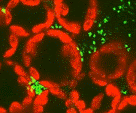Plant Pathology, Department of

Department of Plant Pathology: Faculty Publications
Document Type
Article
Date of this Version
11-23-2023
Citation
Marín-Ponce LF, Rodríguez-Puerto C, Rocha-Loyola P and Rojas CM (2023) The Pseudomonas syringae pv. tomato DC3000 effector HopD1 interferes with cellular dynamics associated with the function of the plant immune protein AtNHR2B. Front. Microbiol. 14:1305899. doi: 10.3389/fmicb.2023.1305899
Abstract
The plant pathogenic bacterium Pseudomonas syringae pv. tomato DC3000 (Pst DC3000) causes disease in tomato, in the model plant Arabidopsis thaliana, and conditionally in Nicotiana benthamiana. The pathogenicity of Pst DC3000 is mostly due to bacterial virulence proteins, known as effectors, that are translocated into the plant cytoplasm through the type III secretion system (T3SS). Bacterial type III secreted effectors (T3SEs) target plants physiological processes and suppress defense responses to enable and support bacterial proliferation. The Pst DC3000 T3SE HopD1 interferes with plant defense responses by targeting the transcription factor NTL9. This work shows that HopD1 also targets the immune protein AtNHR2B (Arabidopsis thaliana nonhost resistance 2B), a protein that localizes to dynamic vesicles of the plant endomembrane system. Live-cell imaging of Nicotiana benthamiana plants transiently co-expressing HopD1 fused to the epitope haemagglutinin (HopD1-HA) with AtNHR2B fused to the red fluorescent protein (AtNHR2B-RFP), revealed that HopD1-HA interferes with the abundance and cellular dynamics of AtNHR2B-RFP-containing vesicles. The results from this study shed light into an additional function of HopD1 while contributing to understanding how T3SEs also target vesicle trafficking-mediated processes in plants.
Video_1_The Pseudomonas syringae pv. tomato DC3000 effector HopD1 interferes with cellular dynamics associated with the function of the plant immune p.AVI (3182 kB)
Video_2_The Pseudomonas syringae pv. tomato DC3000 effector HopD1 interferes with cellular dynamics associated with the function of the plant immune p.AVI (4002 kB)


Comments
Open access.